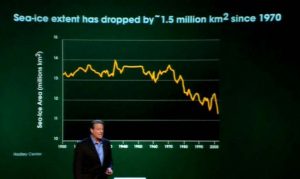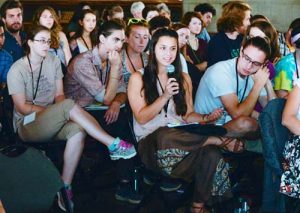Awareness is Not Action
 The first time I heard the words “climate change,” I was thirteen years old. My older brother urged my parents to take us to a documentary called “An Inconvenient Truth.” I lamented as our parents loaded us into the car to go see it. I don’t remember being affected much by Al Gore’s forklift-sized graphs. But the words — climate change—have echoed through my life ever since.
The first time I heard the words “climate change,” I was thirteen years old. My older brother urged my parents to take us to a documentary called “An Inconvenient Truth.” I lamented as our parents loaded us into the car to go see it. I don’t remember being affected much by Al Gore’s forklift-sized graphs. But the words — climate change—have echoed through my life ever since.
It was another six years before I heard the words “climate movement.” And I kept hearing it. But I didn’t know what this thing was, or where it was, or how to be a part of it. In my second year at university, those questions drove me to a conference in Pittsburgh called National Powershift.
 There, I found thousands of other young people who were all talking about the “Climate Movement”—how to build it, what needed to be achieved, what the “targets” were. It was electric. I ended up at a workshop titled “Food Justice 101.” I’d never heard the concept before and only remember feeling uninterested when I left: “I don’t want to focus on grocery stores and community gardens, I’m trying to do something political, something that builds the power of our movement.” I didn’t look back.
There, I found thousands of other young people who were all talking about the “Climate Movement”—how to build it, what needed to be achieved, what the “targets” were. It was electric. I ended up at a workshop titled “Food Justice 101.” I’d never heard the concept before and only remember feeling uninterested when I left: “I don’t want to focus on grocery stores and community gardens, I’m trying to do something political, something that builds the power of our movement.” I didn’t look back.
But now, I’m writing these words as a member of a collective of young people who have been building a vegetable farm south of Roanoke, Virginia. Since that first encounter with the movement, I’ve come to believe that growing food, and doing it in a way that enhances community autonomy, as well as ecological restoration, is one of the most important and powerful means of building a social movement in the face of climate change. And, similarly, I’ve come to understand that the systematic deprivation and control of people’s access to the means of producing and accessing healthy food is one of the most political determinants of our world.
It’s taken time and a lot of experimentation to cultivate this perspective.
As I was initially becoming active in the youth climate movement, most tactics being employed were centered on generating awareness of the crisis. If we can just get enough people to recognize the severity of the impending catastrophe, the political will to redirect our course will be made. The formulation and evaluation of tactics was then measured quantitatively by how many people saw it happen—how many news articles there were, Facebook shares, retweets. I remember spending hours after participating in rallies and marches tracking how far the news of it was spreading online.
 But awareness, at most, is a catalyst of social transformation, not its substance or driving force. The Washington Post recently reported that the solid majority of American youth are “convinced that humans are changing Earth’s climate and believe that it will cause harm to them personally and to other members of their generation.” Should we conclude that our efforts should be geared towards swaying those who make up the remaining percentage of ‘deniers’? I think, instead, the conclusion is that there are already enough young people who are clear-eyed about what is at stake. We don’t lack awareness. What is lacking are the methods and potency of action.
But awareness, at most, is a catalyst of social transformation, not its substance or driving force. The Washington Post recently reported that the solid majority of American youth are “convinced that humans are changing Earth’s climate and believe that it will cause harm to them personally and to other members of their generation.” Should we conclude that our efforts should be geared towards swaying those who make up the remaining percentage of ‘deniers’? I think, instead, the conclusion is that there are already enough young people who are clear-eyed about what is at stake. We don’t lack awareness. What is lacking are the methods and potency of action.
With this situational perspective in mind, I’ve been experimenting with other Virginians on ways to change the material position from which young people can take action — not just their ideological position. This, I believe, is the concrete work of movement building.
I’m part of a broader network called the Virginia Student Environmental Coalition. In the last 3 years, we’ve developed a two-pronged approach to our organizing. We simultaneously organize campaigns against the forces and figures that are driving the climate crisis, while also organizing resources to overcome the obstacles stunting young/people’s ability to be agents in this fight for the long-haul. In particular, we’ve confronted student debt, unaffordable rent, and the time-sucking jobs required to bear these burdens alone. We’ve made a habit of organizing resources to face these conditions collectively. In doing so, we support young people in having the energy and time to be active in their communities rather than being neutralized, or worse, inadvertently complicit with the structures that we are trying to fight. This has looked like fundraising and grant-writing to distribute stipends, pay rent, and cover debt-payments that lessen the financial weight that young people face immediately after leaving university.
Our objective now is to broaden the possibility of this initiative by not just supporting the payment of bills, but by generating community-owned resources like land-bases and housing.
It is towards this objective, among others, that I am dedicating my efforts to build our first communally-owned land-base. Through this project we are seeking to develop the means to grow food to feed members of our coalition as well as feed people in the communities of which we are a part.
 Through our involvement in organizing communities to stand against the Mountain Valley Pipeline (MVA), we’ve made connections with a family which, for the time-being, has donated their home and 58 acres of farmland to our coalition. A group of us (composed of young people and older community members) moved into the house to launch a one-year food-production pilot project. Since then, 116 people from all over Virginia have participated in programming that we’ve held at the farm. We grew 2,542 lbs. of food, distributing most of it for free. This was all accomplished with a group of 6 people who were learning how to farm for the first time.
Through our involvement in organizing communities to stand against the Mountain Valley Pipeline (MVA), we’ve made connections with a family which, for the time-being, has donated their home and 58 acres of farmland to our coalition. A group of us (composed of young people and older community members) moved into the house to launch a one-year food-production pilot project. Since then, 116 people from all over Virginia have participated in programming that we’ve held at the farm. We grew 2,542 lbs. of food, distributing most of it for free. This was all accomplished with a group of 6 people who were learning how to farm for the first time.
In the last month, we hosted 35 students from Virginia and North Carolina colleges. They learned about the role that youth have played in fighting the Mountain Valley Pipeline between sessions of working alongside each other to plant fall crops and begin building a greenhouse. This pedagogical approach allows us to demonstrate the need to simultaneously build the strength of our communities while fighting to prevent the destructive forces that threaten them.
We see one of the core values of this project as providing a parallel model of collective living, cooperative working and ecologically regenerative farming that young people can see themselves in. Over five years of building a youth movement in our state, we have been driven by the knowledge that the current world—defined by extraction of the land and exploitation of people, endless war and spiraling environmental devastation–is not an inevitable given. This is not the way the world must be. Another world is possible. But the current paradigm is made insurmountable by our inability to imagine life beyond it. This project has been an experiment in provoking young people’s imagination to see life that isn’t trapped by greed, competition, and individualism.
 We carry forward the pursuit of this possibility on the backs of many who have fought for food and land sovereignty before us. I call forward the words of Fannie Lou Hamer, one of the most powerful voices in the civil rights movement and co-founder of the Mississippi Freedom Democratic Party:
We carry forward the pursuit of this possibility on the backs of many who have fought for food and land sovereignty before us. I call forward the words of Fannie Lou Hamer, one of the most powerful voices in the civil rights movement and co-founder of the Mississippi Freedom Democratic Party:
“Land, too, is important in the 70s and beyond, as we move toward our ultimate goal of total freedom. Because of my belief in land reform, I have taken steps of acquiring land through cooperative ownership. In order for any people or nation to survive, land is necessary. However, individual ownership of land should not exceed the amount necessary to make a living. Cooperative ownership of land opens the door to many opportunities for group development of economic enterprises, which develop the total community rather than create monopolies that monopolize the resources of a community.”
 — Zakaria Kronemer, Rachel Carson Council Fellow. Zacharia is a young activist living and farming is southwest Virginia. Zakaria is working to build a space where other organizers can connect to the land, connect to each other, and witness the impacts of the fossil fuel industry.
— Zakaria Kronemer, Rachel Carson Council Fellow. Zacharia is a young activist living and farming is southwest Virginia. Zakaria is working to build a space where other organizers can connect to the land, connect to each other, and witness the impacts of the fossil fuel industry.